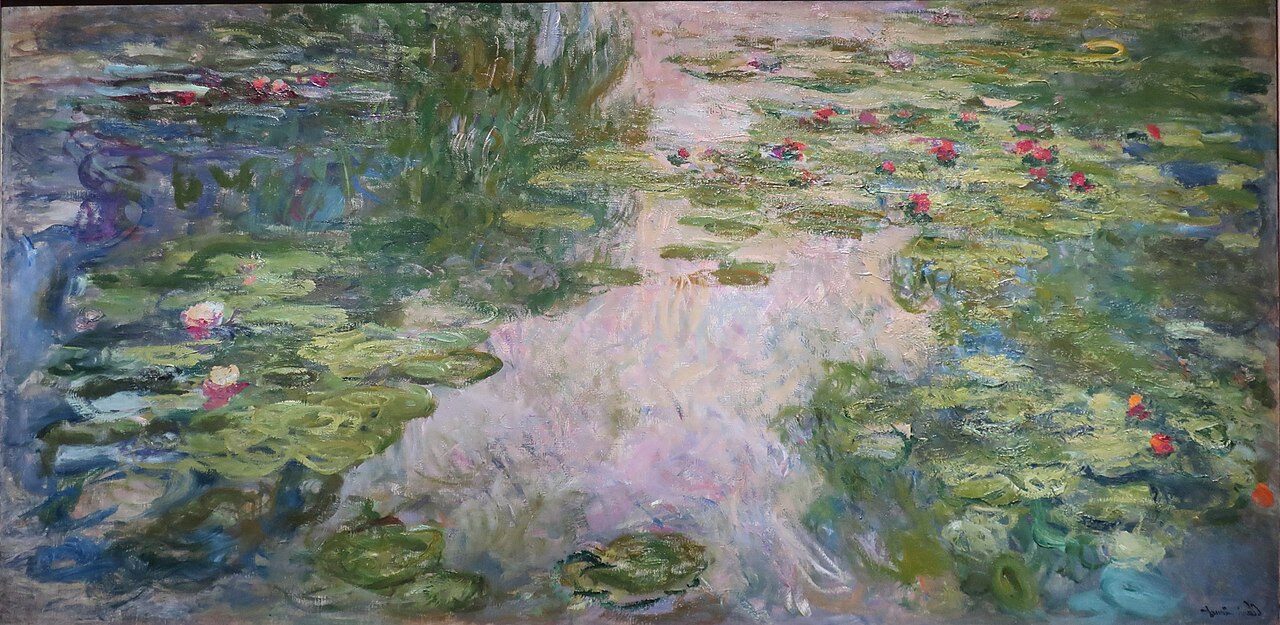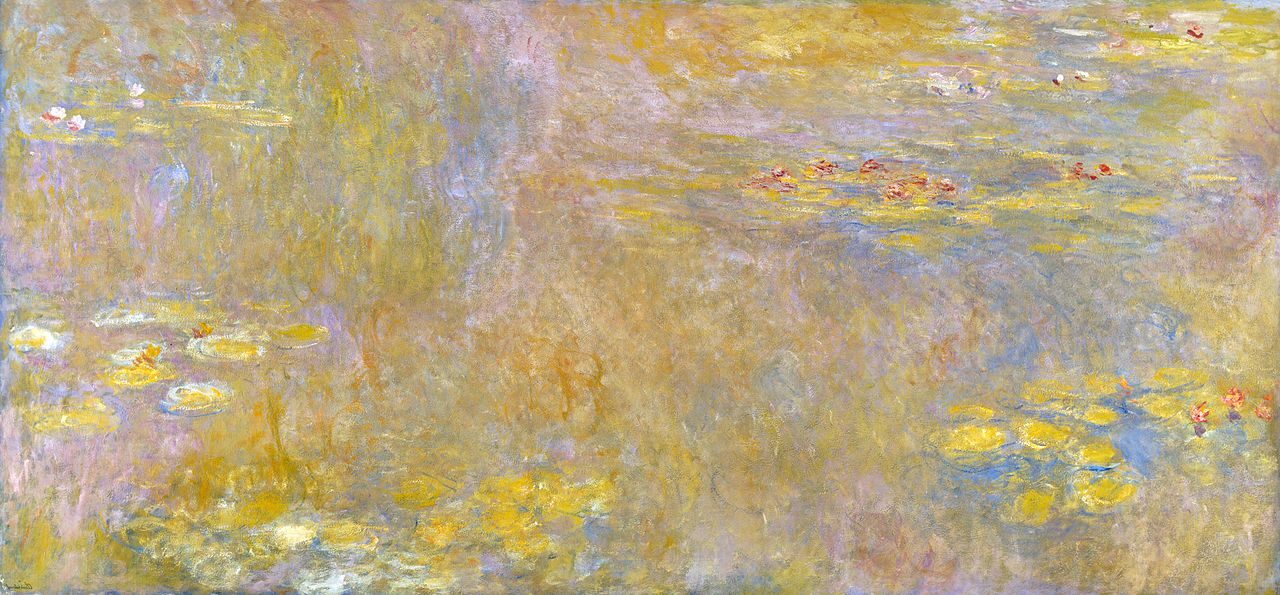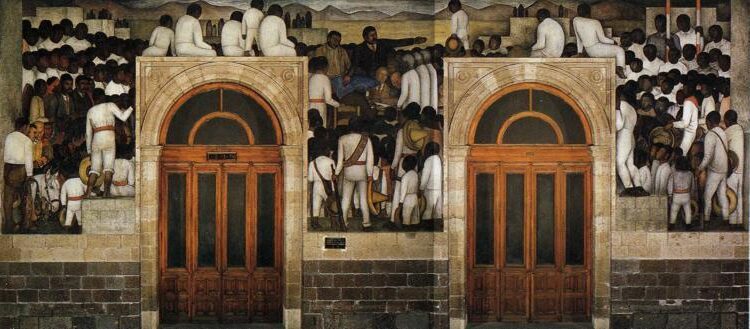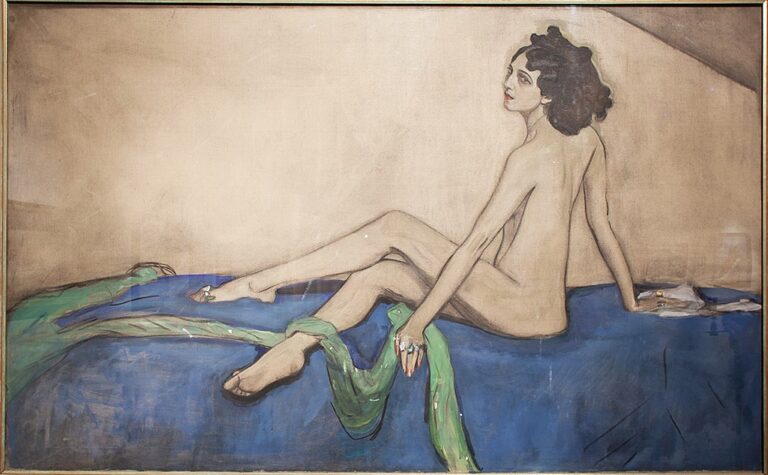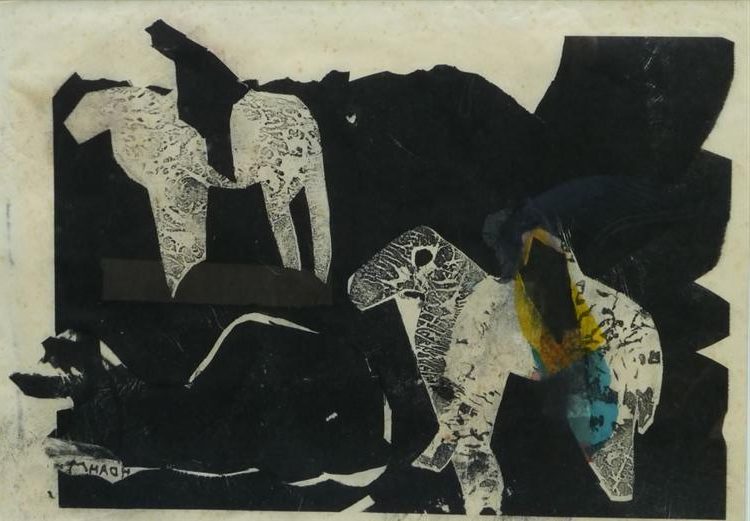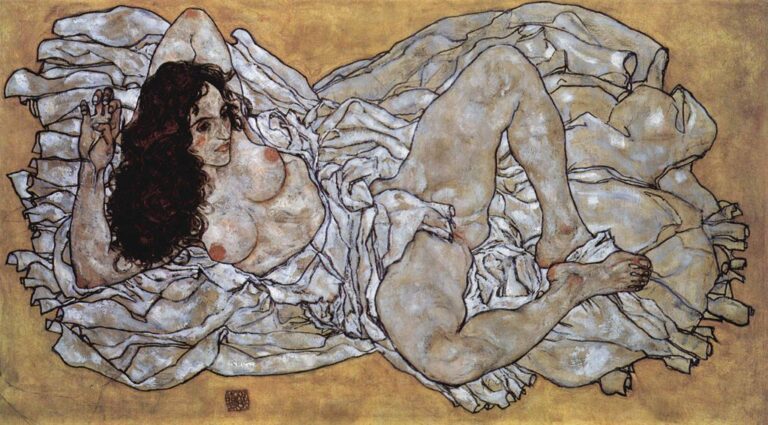Claude Monet: Painter Who Revolutionized Impressionism
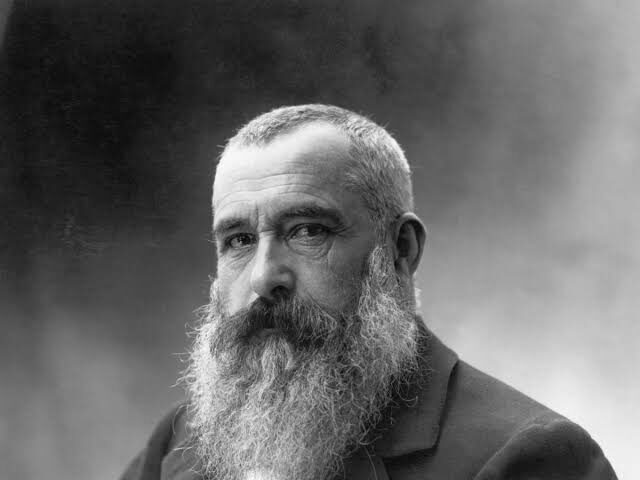
Born: 14 November 1840, Paris, Kingdom of France
Death: 5 December 1926, Giverny, France
Art Movement: Impressionism
Nationality: French
Teacher: Charles Gleyre
Institution: Académie Suisse
Claude Monet: Painter Who Revolutionized Impressionism
Life and Legacy of Claude Monet
Claude Monet transformed the art world with his revolutionary painting techniques. His dedication to capturing light and atmosphere helped establish Impressionism. His artistic journey spanned more than six decades, during which he created some of history’s most recognizable paintings.
Early Life and Artistic Beginnings
Oscar-Claude Monet was born on November 14, 1840, in Paris, France. His family moved to Normandy when he was five, settling in the coastal town of Le Havre where his father operated a grocery business.
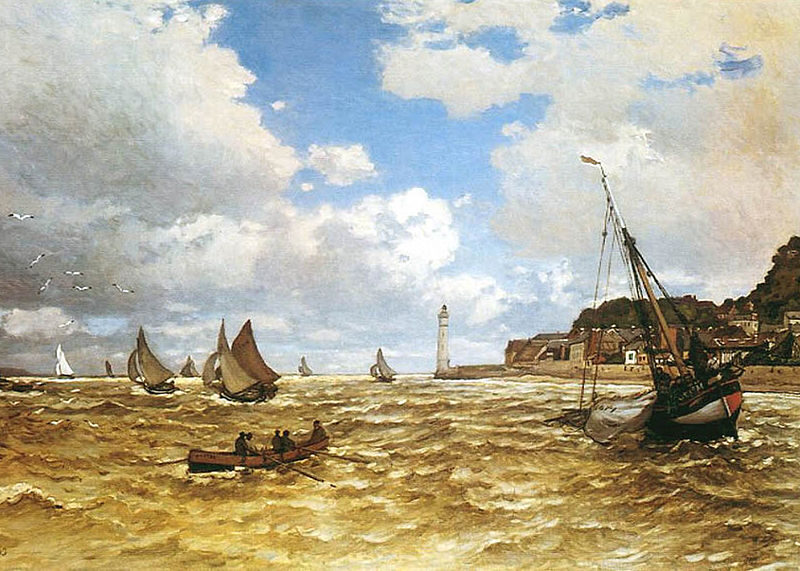
Mouth of the Seine at Honfleur by Claude Monet (1865)
Young Monet showed artistic talent early, creating caricatures that he sold for 10-20 francs each. These early commercial successes demonstrated his natural ability.
In 1857, Monet met landscape artist Eugène Boudin, who encouraged him to paint outdoors—a practice known as “en plein air.” This mentorship profoundly influenced Monet’s approach to art.
After military service in Algeria, Monet studied at Académie Suisse in Paris, where he met Camille Pissarro. He later trained under Charles Gleyre, forming friendships with Pierre-Auguste Renoir, Alfred Sisley, and Frédéric Bazille—relationships that would shape the Impressionist movement.
Development of Impressionism
Monet’s 1872 painting “Impression, Sunrise” gave the Impressionist movement its name. Critics initially used the term mockingly, but the artists embraced it as their identity.
Monet and his colleagues rejected traditional studio painting, instead capturing outdoor scenes with visible brushstrokes and vibrant colors. They focused on depicting light’s changing qualities rather than exact details.
The first Impressionist exhibition took place in 1874, challenging the strict standards of the official Paris Salon. Though initially controversial, these exhibitions helped establish Impressionism as a legitimate artistic movement.
Monet’s series paintings—multiple works of the same subject under different light conditions—became his signature approach. His haystacks, water lilies, and Rouen Cathedral series demonstrated his fascination with how light transforms perception throughout the day.
Major Works and Exhibitions
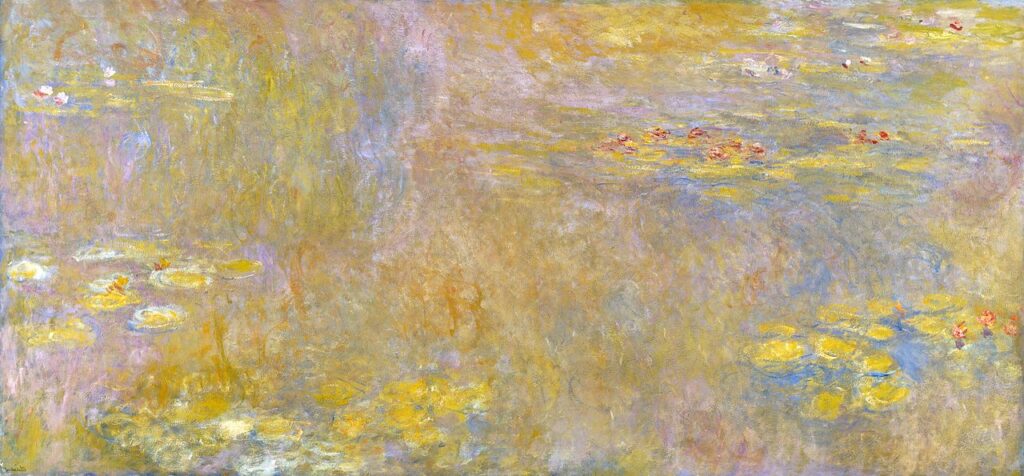
Water Lilies by Claude Monet (1920)
Monet’s most celebrated works include:
- Water Lilies series (1897-1926): Over 250 paintings featuring his Giverny garden pond
- Haystacks series (1890-1891): Capturing the same haystack formations in different seasons and times
- Rouen Cathedral series (1892-1894): Depicting the cathedral façade in varying light conditions
- Houses of Parliament series (1899-1901): Showing London’s landmark building at different times
In 1883, Monet settled in Giverny, creating elaborate gardens that became his primary painting subjects. His water garden with its Japanese bridge and lily pond appears in his most iconic later works.
Financial success came gradually. Art dealer Paul Durand-Ruel organized exhibitions that increased Monet’s recognition and sales, particularly in America where collectors eagerly purchased his paintings.
Later Years and Death
Despite developing cataracts that affected his vision after 1912, Monet continued painting. His later works grew larger and more abstract, with looser brushwork and intensified colors.
The French government commissioned Monet’s massive water lily paintings for display at the Orangerie Museum. This project consumed his final years as he worked on enormous curved canvases designed to surround viewers.
Monet maintained his dedication to painting until his death on December 5, 1926, at age 86. He was buried in the Giverny church cemetery.
His Giverny home and gardens opened to the public in 1980, becoming a popular tourist destination that preserves his living environment and artistic inspiration.
Monet’s innovative techniques influenced generations of artists, and his paintings now command millions at auction.
Artistic Style and Techniques
Monet’s distinctive approach to painting revolutionized the art world through his innovative use of color, light, and brushwork. His techniques captured fleeting moments and atmospheric effects that traditional painting methods could not achieve.
Impressionist Color Theory
Monet rejected the use of black in his paintings, believing it dulled colors. Instead, he created shadows using complementary colors—purples and blues to contrast with yellows and oranges.
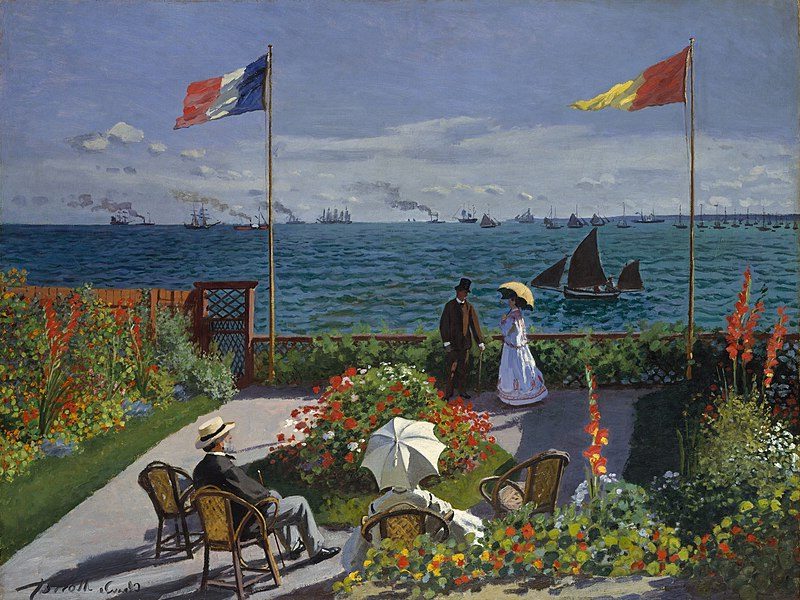
Garden at Sainte-Adresse (“Jardin à Sainte-Adresse”) by Claude Monet (1867)
He painted with a limited palette but achieved remarkable color variety through careful mixing and placement. His famous “haystacks” and “water lilies” series demonstrate how the same subject could appear dramatically different under varying light conditions.
Monet often applied colors side by side rather than blending them completely. This technique, called optical mixing, forces viewers’ eyes to combine the colors visually, creating more vibrant and dynamic effects than physical mixing.
During his career, Monet’s palette grew increasingly bold, especially in his later works where purples, blues, and pinks dominate many compositions.
En Plein Air Painting
Monet was a dedicated outdoor painter, working “en plein air” (in the open air) whenever possible. He often painted the same scene multiple times to capture changing light and weather conditions.
His custom-built studio boat allowed him to paint directly from the water, providing unique perspectives of rivers and reflections. This floating studio gave him access to viewpoints impossible to reach from shore.
Monet designed his famous garden at Giverny specifically to provide subjects for his paintings. The water lily pond, Japanese bridge, and flower beds became his primary outdoor studio for nearly 30 years.
Working outdoors presented challenges like changing light, wind, and weather. Monet developed techniques to work quickly, sometimes using several canvases simultaneously to capture different moments of the day.
Brushwork and Texture
Monet’s distinctive brushwork evolved throughout his career. His early work showed controlled, traditional technique, but he gradually developed looser, more expressive strokes.
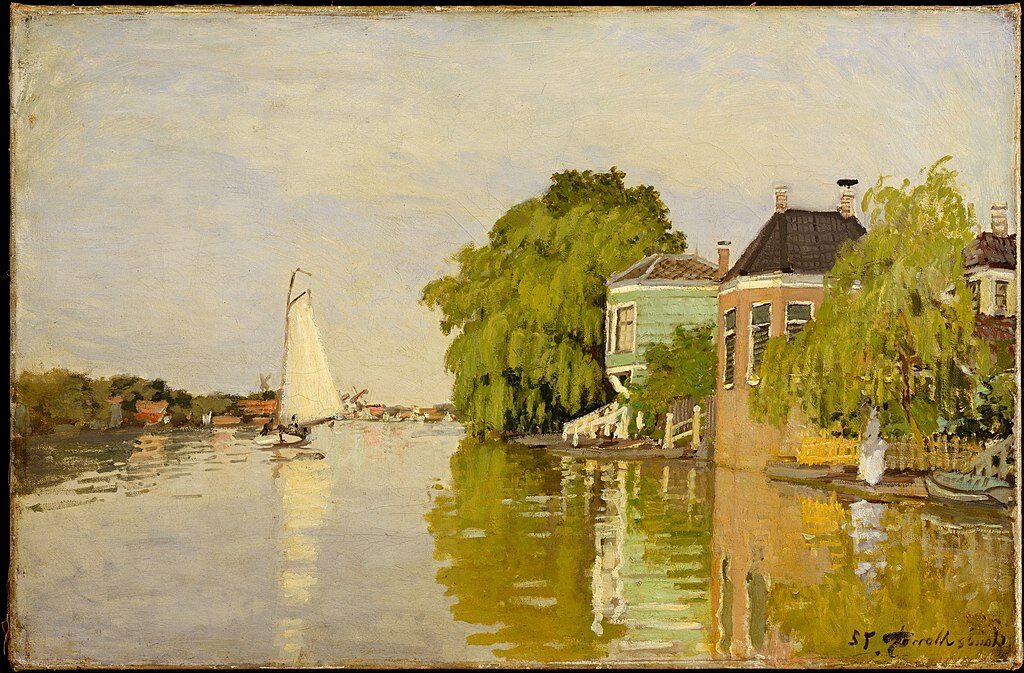
Houses on the Achterzaan – Claude Monet (1871)
He often used short, comma-like brushstrokes placed side by side to create vibrating energy in his paintings. This technique helped capture the movement of water, clouds, and foliage in scenes that appear alive with motion.
Monet applied paint with varying thicknesses. In some areas, his canvas shows through thin washes; in others, thick impasto creates textural surfaces that catch actual light, enhancing the painting’s luminosity.
Rather than carefully blending transitions, he created broken color fields that appear to shimmer. This approach revolutionized how artists could represent atmospheric effects.
Light and Reflection
Light was Monet’s true subject, more important than the objects it illuminated. He was fascinated by how changing light transformed ordinary scenes into extraordinary visual experiences.
His water lily paintings demonstrate his mastery of depicting reflections. He painted both the surface objects and their reflections with equal attention, creating complex compositions where reality and reflection merge.
Monet’s cathedral series shows the same Rouen Cathedral facade at different times of day. These paintings reveal how dramatically light can transform solid stone through subtle color changes.
In his later years, as his eyesight deteriorated from cataracts, his perception of color shifted toward reds and yellows. Rather than limiting him, this condition pushed his work toward greater abstraction and more radical color explorations.
Impact and Influence
Claude Monet’s artistic innovations transformed painting forever. His techniques and vision continue to shape art, culture, and even tourism around the world.
Influence on Modern Art
Monet’s revolutionary approach to capturing light and color paved the way for modern art movements. His break from traditional representation inspired future artists to experiment with perception and abstraction.

Reflections of Clouds on the Water-Lily Pond – Claude Monet (c. 1920)
The Impressionist movement he helped found challenged academic painting standards and changed how artists approached their subjects. Instead of clearly defined forms, Monet emphasized the visual experience of a scene.
His later works, particularly the Water Lilies series, influenced Abstract Expressionism with their focus on color, surface, and emotional response rather than recognizable imagery.
Art historians credit Monet with developing techniques that freed painting from strict representation, allowing artists to explore more personal and experimental approaches to their work.
Monet’s Gardens at Giverny
Monet’s home and gardens at Giverny became his living studio and greatest creation beyond his canvases. He designed these gardens specifically to paint them, creating scenes that merged nature and art.
The famous Japanese bridge, water lily pond, and flower arrangements were carefully planned to provide endless painting subjects. Monet spent more than 40 years cultivating and painting these gardens.
Today, Giverny attracts nearly 500,000 visitors annually. The restored gardens look much as they did during Monet’s lifetime, allowing visitors to step into the living landscapes of his most famous paintings.
The gardens represent Monet’s vision coming full circle—he created the gardens to paint them, and now they exist as a physical embodiment of his artistic legacy.
Preservation of His Works
Major museums worldwide showcase Monet’s paintings as centerpieces of their collections. The Musée Marmottan Monet in Paris houses the largest collection with over 100 of his works.
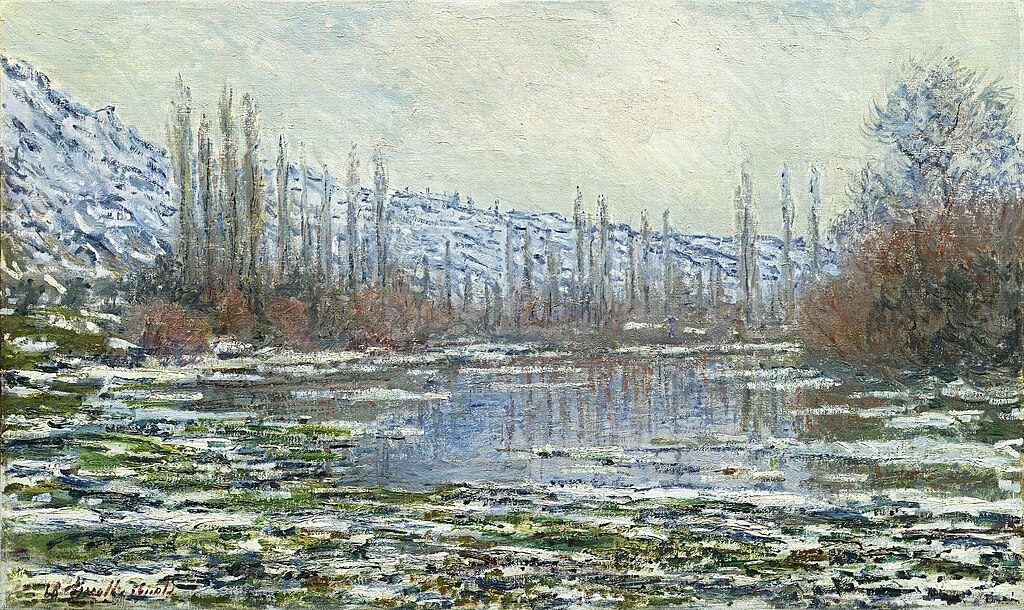
The Thaw at Vétheuil by Claude Monet (1880)
Conservation efforts present unique challenges due to Monet’s techniques. His thick paint application (impasto) and layering methods require specialized care to preserve the vibrant colors and textural qualities that define his style.
Digital preservation projects have documented his works in high resolution, allowing researchers to study his brushwork techniques and color choices in unprecedented detail.
Claude Monet’s paintings continue to break auction records. In 2019, a painting from his Haystacks series sold for $110.7 million, demonstrating the enduring value placed on his artistic contributions.
Beyond their aesthetic value, Monet’s paintings also highlight an important financial dimension: art as an investment. Once dismissed by critics, his canvases now sell for record-breaking sums, showing how artistic passion can intersect with the world of great fortunes. This balance between creativity and financial worth continues to spark discussions around art and legacy.
Frequently Asked Questions
Claude Monet’s work raises many questions about his techniques, artistic evolution, and contributions to the art world.
What are the defining characteristics of Claude Monet’s impressionist painting style?
Monet’s style features visible brushstrokes that appear quick and spontaneous. He used pure, unmixed colors placed side by side to create vibrant effects.
His paintings capture fleeting moments and changing light conditions rather than static scenes. Monet often painted the same subject multiple times to show how light transformed it throughout the day.
He focused on outdoor scenes (en plein air painting) rather than studio work. His compositions typically lack hard outlines, with forms suggested through color relationships rather than defined edges.
How did Claude Monet’s work evolve throughout his career?
Monet began with more traditional landscape paintings before developing his impressionist techniques in the 1860s and 1870s. His early impressionist works explored urban and rural scenes with a focus on capturing light effects.
In the 1880s, he began creating series paintings of the same subject under different lighting conditions. The 1890s saw him start his water lily paintings at his garden in Giverny.
His later works, especially after 1900, became increasingly abstract with larger canvases and a focus on color and atmosphere rather than recognizable forms. His eyesight problems led to broader brushwork and more intense colors in his final years.
What are some of Claude Monet’s most famous paintings, and what makes them significant?
“Impression, Sunrise” (1872) gave the Impressionist movement its name and shows Monet’s revolutionary approach to capturing light. “Water Lilies” series (1899-1926) represents his most famous work, exploring reflections and the boundary between water and air.
“Rouen Cathedral” series (1892-1894) demonstrates his fascination with how light changes the appearance of a single subject. “Haystacks” series (1890-1891) similarly shows how time of day and seasons transform landscapes.
“Woman with a Parasol” (1875) captures his wife and son in a spontaneous outdoor moment with brilliant light and movement. These works are significant for their technical innovation and their influence on later art movements.
Can you describe the influence of Claude Monet’s work on the development of modern art?
Monet helped break away from academic traditions in painting, giving permission to future artists to explore new approaches. His focus on light and color over line and form directly influenced Post-Impressionism, Fauvism, and Abstract Expressionism.
His serial paintings exploring the same subject under different conditions introduced concepts that would later be explored in conceptual art. Monet’s late water lily paintings, with their near-abstract qualities, prefigured abstract art of the 20th century.
His emphasis on the artist’s personal perception rather than objective reality influenced many modern art movements. Artists from Matisse to Pollock acknowledged Monet’s revolutionary approach to color and composition as foundational to their work.
What techniques did Claude Monet employ to capture the effects of light and color in his paintings?
Monet used broken brushwork with small, visible strokes to create a sense of movement and vibration. He adopted optical mixing, placing pure colors side by side for the viewer’s eye to blend rather than mixing paints on his palette.
He painted quickly to capture momentary light effects before they changed. Monet often used complementary colors to create vibrant contrasts and visual excitement.
He typically worked on multiple canvases simultaneously to capture different lighting conditions of the same scene. His understanding of color theory led him to recognize that shadows contain color, not just darkness, revolutionizing how artists depicted light.
How did Claude Monet’s personal life and the places he lived influence his artwork?
Monet’s childhood in Normandy established his lifelong connection to coastal landscapes and changing skies. His time in Paris connected him with other innovative artists and exposed him to urban scenes that appeared in his early impressionist works.
His homes in Argenteuil, Vétheuil, and finally Giverny became subjects for hundreds of paintings. The garden he created at Giverny, with its famous water lily pond and Japanese bridge, provided subjects for his most iconic works.
Financial struggles in his early career made him sensitive to marketable subjects, while later success allowed more experimental work. Personal losses, including the death of his first wife Camille and his deteriorating eyesight, influenced the emotional tone and techniques in his later paintings.

